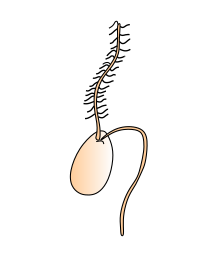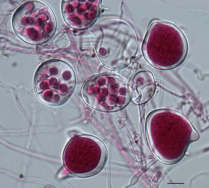Zoospore

A zoospore is a
Diversity
General morphology
Zoospores are composed of a microtubular cytoskeleton base which extends from the base of the flagellum. The complexity and structure of this cytoskeleton is variable and is largely dependent on volume and size.[2] One common feature of zoospores is their asymmetrical shape; a result of the ventral grove housing the flagella base. Certain zoospores progress through different phases, the first phase commonly referred to as 'the initial'.[2] Others form cysts that vary tremendously in volume (14-4905 cubic micrometers) and shape, each with distinctive hair structures.[2]
Flagella types
Zoospores may possess one or more distinct types of flagella - tinsel or "decorated", and whiplash, in various combinations.
- Tinsellated (straminipilousmastigonemes perpendicular to their main axis, which allow for more surface area, and disturbance of the medium, giving them the property of a rudder, that is, used for steering.
- Whiplash flagella are straight, to power the zoospore through its medium. Also, the "default" zoospore only has the propelling, whiplash flagella.
Both tinsel and whiplash flagella beat in a
Attachment to the base of the zoospore is variable between taxa and may help with identification of species.[2]
Morphological types

In
- Posterior whiplash flagella are a characteristic of the Neocallimastigaleshave up to 16 (Fig. 1b).
- Anisokonts are biflagellated zoospores with two whip types flagella of unequal length (Fig. 1c). These are found in some of the Plasmodiophoromycota.
- Zoospores with a single anterior flagellum (Fig. 1d) of the tinsel type are characteristic of Hyphochytriomycetes.
- Heterokont are biflagellated zoospores (Fig. 1e, f) with both whiplash (smooth) and tinsel type (fine outgrowths called mastigonemes) flagella attached anteriorly or laterally. These zoospores are characteristic of the heterokonts.
Zoosporangium

A zoosporangium is the asexual structure (
Infectivity
Different fungal zoospores may infect different taxa of organisms. Due to zoospores' aquatic lifestyle,[1] fish and amphibians are ideal hosts. Some colonize exposed injuries in fish which may cause epidermal damage, leading to death in certain cases.[5] Others may utilize species of frogs (such as Bufo marinus and Rana catesbieana) as carriers, allowing extended ranges of travel.[1]
See also
- Angiosperm
- Fern
- Gametangium
References
- ^ a b c d O’Rourke, Dorcas P.; Rosenbaum, Matthew D. (2015), "Biology and Diseases of Amphibians", Laboratory Animal Medicine, Elsevier, pp. 931–965, retrieved 2023-11-08
- ^ ISBN 978-0-12-384733-1, retrieved 2023-11-08
- ^ ISBN 9780521014830.
- PMC 126747.
- ISBN 978-0-12-409527-4.
- Alexopoulos, C. J.; Mims, Charles W.; Blackwell, M.; et al. (2004). Introductory Mycology (4th ed.). Hoboken, New Jersey: John Wiley and Sons. ISBN 0-471-52229-5.
External links
 Media related to Zoospores at Wikimedia Commons
Media related to Zoospores at Wikimedia Commons
